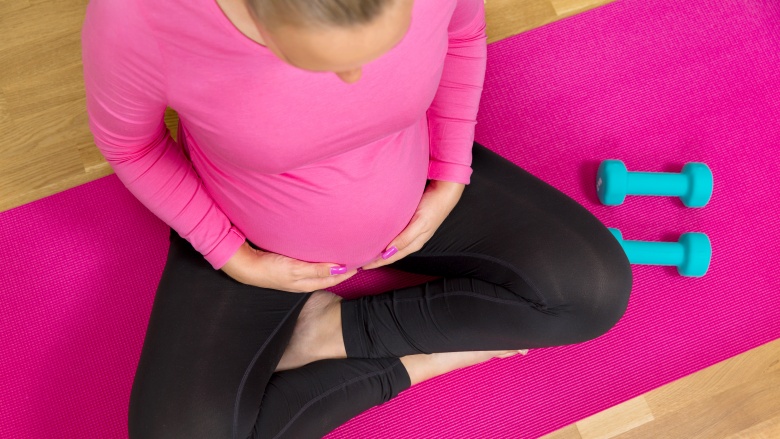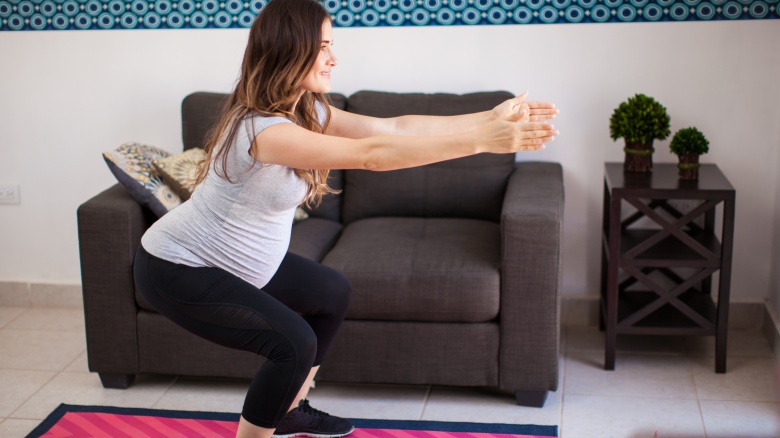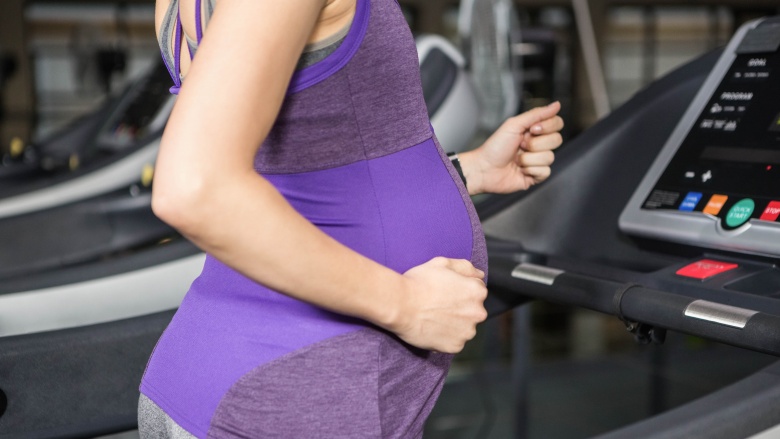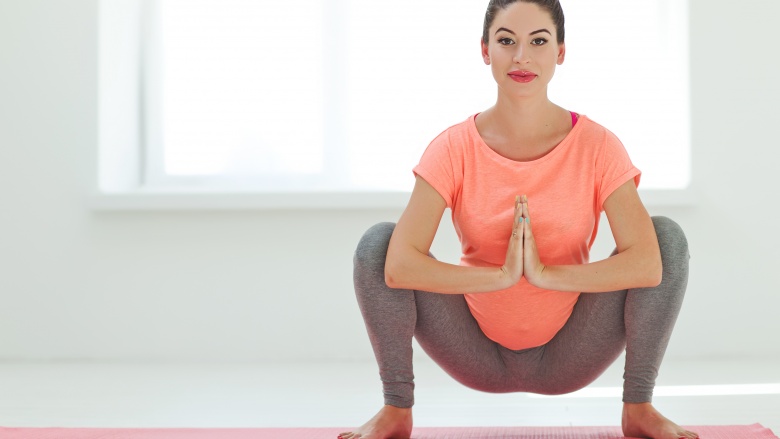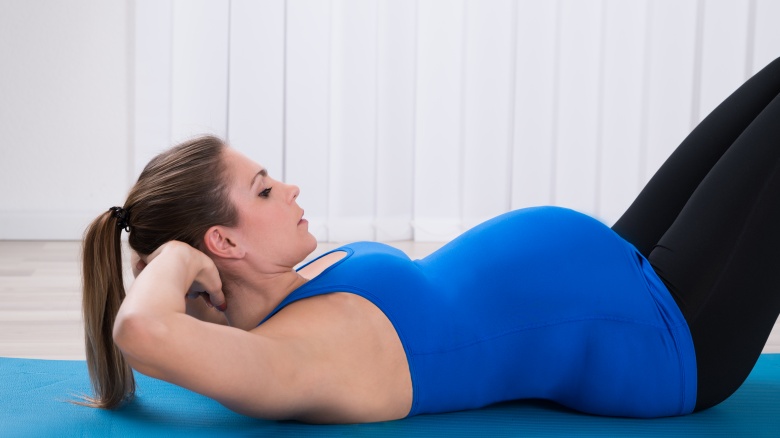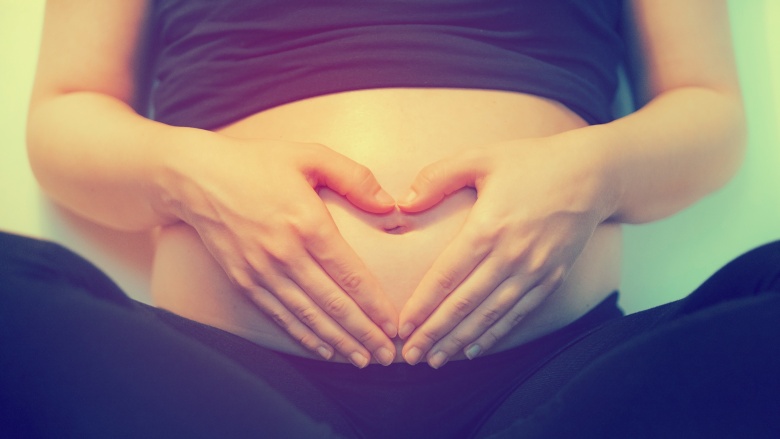Things Pregnant Women Need To Know About Fitness
Hooray! All that tough work in the bedroom finally paid off, resulting in a positive sign on your pregnancy exam. And while all that "studying" probably resulted in some heavy breathing and sweating (at least for your sake we hope it did), the hard work has only just begun. Mama, you've got a lifetime of happy challenges in front of you, and you need to be fit for whatever your new baby brings. I spoke with Sara Haley, a Los Angeles-based fitness specialist and the creator of three award-winning programs, the excuse-proof workout Sweat UNLIMITED, the prenatal workout Expecting MORE, and the postnatal program Expecting More: The 4th Trimester Workout, to get the scoop on everything you need to know about exercising while pregnant. Haley herself is a mother of two and one of the most sought-after prenatal and postnatal experts in the fitness industry, so you know she's got your back (and your cute growing belly).
Exercise is safe and beneficial for moms and babies
As tempting as it is to view your positive pregnancy test as an excuse to lie on the couch as your partner hand-feeds you ice cream by the spoonful — because "baby!" — pregnancy actually isn't actually a good reason to act like a sloth. In fact, thought leadership on pregnancy (backed by scientific research) has changed significantly over the last 50 years, highlighting what most moms already know: pregnancy isn't an illness; it doesn't make you weak or turn you into a wilting flower. There are very, very few reasons for you to limit activity during pregnancy, and there are lots of reasons you should be active. Fitness specialist Sara Haley points to her top three: "First, you are literally creating a human inside your body. Your body should ultimately be in the healthiest state possible for this mission. Second, being fit helps ease the process of labor and delivery. While labor and delivery can be challenging whether you're fit or not, the stamina and willpower you gain from exercise helps you tremendously when your baby decides to come. And third, exercising during pregnancy helps make your postnatal recovery easier." While Haley admits postnatal recovery, like labor, is tough for everyone, "exercising during pregnancy helps you minimize weight gain and keeps your muscles strong so your postnatal recovery is quicker and more efficient." Plus, pregnancy isn't just good for you, it's good for your baby, too. A 2014 study published in Early Human Development found that babies whose moms exercised regularly during pregnancy had lower fetal heart rates and greater heart rate variability at 36-weeks gestation and at one-month post-birth. Essentially, exercise during pregnancy can improve your baby's heart health before and after delivery.
If you weren't exercising before, you should ease into it slowly
Of course you should always talk to your doctor about potential risks before diving head-long into a prenatal exercise routine, but even if you haven't been regularly active, there's almost no reason you can't start hitting the gym. Haley points out that anyone new to exercise should ease into it more slowly, paying greater attention to what feels good and what doesn't. Heck, now is certainly not the time to sign up for a hardcore boot camp. Rather, you might want to consider the benefits of enlisting a personal trainer with an expertise in prenatal fitness to help build your confidence as you develop a new habit. And if the cost of a personal trainer falls outside your budget, pick up a prenatal workout DVD for reference, like Haley's own Expecting More DVD and streaming workouts.
You should keep your intensity level moderate
Of course there are the women who make headlines for running marathons and doing CrossFit into the final months of their pregnancies, but the reason they make headlines is that they're the exception to the rule. While it can be perfectly safe for a woman to maintain her pre-pregnancy workout throughout her baby's gestation, the reality is that due to a growing belly, an increased body weight, and all the associated discomforts that accompany pregnancy, most women do need to take their workouts a little easier. Haley says, "My general rule is to work out at a moderate level for you." This is different for every woman based on her pregnancy experience and her fitness level before getting pregnant. To help guide you, Haley offers the following tips: "You should make sure you can always talk out loud while exercising and you should exert yourself only to a level where you're not at risk for getting overheated during your workout." And if you're just not sure? Take it easy. Give yourself permission to slow down, take water breaks, and treat yourself with kindness during every workout.
You have lots of exercise options
"Most doctors recommend prenatal yoga, walking, and swimming during pregnancy, which are all really great," Haley tells us, but they're not your only options. In fact, there are very few exercises that are actually off-limits, so if you enjoy Zumba, running, indoor cycling, or step class, by all means, continue your favorite activity until it becomes too uncomfortable or challenging. Haley adds, "I think strength training during pregnancy is probably one of the most important things you can do. You have so much to carry and lift as a new mom. Plus, strengthening the postural muscles will help ease pain during pregnancy." Sure, it may not seem like a big deal a couple of months in, but as your belly grows and your center of gravity changes, you'll be grateful you put in the work to help carry the load.
Some exercises may not be safe
While most exercises and workouts are considered safe for pregnant women, there are a few that should be avoided. Haley states that generally speaking, crunches, twisting exercises, and high-impact activities, or activities where there's a big risk of falling, should be avoided. For instance, you probably shouldn't go snow skiing or horseback riding while pregnant, and you'll likely want to avoid plyometric box jumps and slacklining. It's also smart to avoid exercise in excessively hot temperatures, like a hot yoga class. Otherwise, if the exercise feels comfortable and your doctor gives you clearance to do it, you should feel good about almost all physical activities.
You can get your body back after giving birth
It's true that your body changes during pregnancy, and you may never have the exact same body you had at 20 that you have as a new mom. Your hips may widen, your skin may feel looser, and you might have scars and stretch marks to show as the status symbols of being a new mom. But, truth be told, do you really want your body to be the same as it was when you were 20? A woman's body and mind grow and change throughout life. That's a really good thing. That said, it's perfectly acceptable to want to tighten back up and lose the baby weight. And as Haley points out, you can. In fact, she put together a calendar for her Expecting MORE: 4th Trimester Workout to help you achieve your postpartum fitness goals. But she does emphasize that "the most important thing is to listen to your doctor. Do not start exercising before you've received approval, and do not start back too fast, too soon, or too hard." Remember, it took you nine months to grow a baby — nine months for your body to undergo significant physical change. You can't and shouldn't expect everything to bounce right back overnight.
Start with the Resistance Fight post-birth core exercise
To get started with a postpartum workout, check out Haley's favorite four moves. She gets it. "My core was the area most affected by my pregnancies, and it's an area all moms need to be strong — your abs and low back help support you in functional, everyday activities, from cooking and cleaning to lifting and carrying your baby." Haley's innovative seated core exercise, the "resistance fight," helps strengthen the entire core while tighten your abs so you can maintain good posture, live pain-free, and get your abs back after baby. Lie on your back and lift one leg up to a tabletop position so your knee is in line with your hip. Take your opposite hand and push against your thigh. As you try to push your leg away with your hand, resist by pushing your leg into your hand in opposition. While you're pushing and resisting, focus on pulling your navel toward your spine and "closing" your rib cage. You may feel your body start to shake. Begin by holding the position for 15 seconds on each side, gradually increasing to 45 seconds per side.
Try Towel Tighteners for your arms and back
Your upper body is easy to overlook before you give birth, but fitness expert Haley reminds us: "As a new parent, you are constantly picking up and carrying your little ones (and all of their stuff), which means your arm and back muscles are needed more than ever before." Movements like Haley's own Towel Tighteners help create strong, lean muscles to help you keep up with your baby. Hold a towel behind your back in both hands, your arms straight so the towel is parallel to the floor. Stand with your feet shoulder-width apart. Soften your knees and hinge forward at the hips. Consciously draw your navel to your spine, engaging your core, as you lift your hands up behind your back as far as you can, tightening your triceps as you simultaneously squeeze your shoulder blades together. Lower your hands back down and repeat for 15 to 30 reps, working your arms to fatigue.
Do the Go Time exercise for better endurance
You thought life was tough before you had a baby, but now, more than ever, you need the endurance to keep going. As Haley points out to us: "Before you know it, your little ones will be crawling, walking, and eventually running! Cardio exercise is key to helping increase your endurance so you can keep up with your little one." Interval drills, like Haley's "Go Time" exercise, paired with active recovery exercises like core work and marching in place, help burn fat even after your workout is complete. This exercise was inspired by the reality that as a mom, no matter how organized you are, you're always one minute away from some form of chaos. You always need to be ready to go. There are actually three options for this move, which you can progress through as you get stronger. Begin by doing a football run (shown in the first image). Count to four in the stationary run, then walk your feet together into a squat (shown in the second image), then back out wide again to continue the exercise. The second option is after the football run, you scoot your feet together so you're on your toes (shown in picture three) before walking them back out into a squat. The final option is that after the football run, you jump up into the air before landing back into a squat and continuing. Regardless of which option you choose, continue for 20 to 60 seconds, before alternating with an active rest exercise, such as walking, marching in place, or planking.
Incorporate the Baby Back Relief exercise for recovery
Too often, stretching and recovery exercises are viewed as expendable — they're always the first thing to go when you're short on time. And yet, fitness expert Haley emphasizes that "as a mom, your body will often feel taxed. It's important to incorporate dynamic stretching into your workout routine to help your muscles recover and keep your body from feeling tense, tight and overused." Grab a towel to perform the Baby Back Relief exercise. Sit on the floor with your legs stretched out in front of you. Place the towel under the arches of your feet. Bend your knees as much as you need to, tuck your chin to your chest, engage your core, and pull on the towel as you round your back. You should feel a stretch in your back. Hold the position for four counts before releasing and repeating four to six times.


